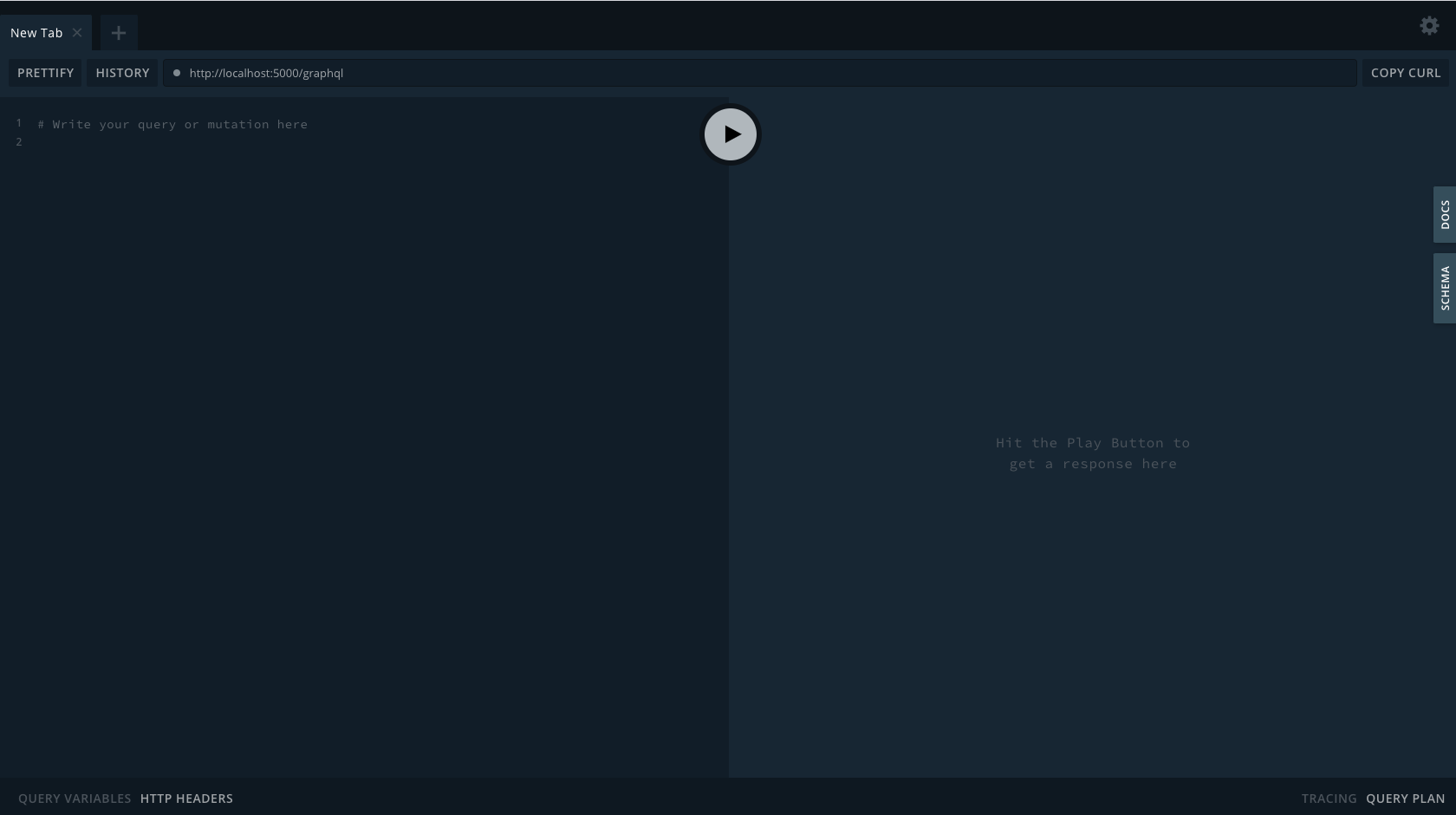This repo contains the starter-code for our bootcamp activity.
We will be using the PERN stack. These technologies are easy to learn, allow for fast development speeds, and are popularly used in Blueprint.
- Frontend: React + Redux
- Backend: Node.js + Express.js + Apollo Server
- Database: PostgreSQL
The dev environment is containerized with Docker to minimize setup efforts.
- Install Docker Desktop (skip tutorials): MacOS | Windows (Home) | Windows (Pro, Enterprise, Education) | Linux
# verify your installation by running the following in a terminal
$ docker --version
$ docker-compose --version- Clone this repo and go into the project directory
$ git clone https://github.com/uwblueprint/bootcamp-pern-graphql.git
$ cd bootcamp-pern-graphql
- Fill in backend environment variables in
/backend/.env.sample, then rename the file to.env. Tip: usemv <old-filename> <new-filename>
POSTGRES_DB=bootcamp
POSTGRES_USER=<insert-username-of-your-choice>
POSTGRES_PASSWORD=<insert-password-of-your-choice>
DB_HOST=bootcamp-pern-graphql-db-1
- Fill in frontend environment variables in
/frontend/.env.sample, then rename the file to.env
REACT_APP_GRAPHQL_SERVER_URL=http://localhost:5000
-
Set
eraseDatabaseOnSynctotruein/backend/server.jsso the database will get seeded with test data when we run our application -
Run the application
$ docker-compose up --build
-
Set
eraseDatabaseOnSyncback tofalse. -
Go to http://localhost:3000 in your browser. You should see this:
- Go to http://localhost:5000/graphql in your browser and verify the playground is up and running:
To first setup the application run the following command:
$ docker-compose up --build
On subsequent runs you can omit the --build tag
$ docker-compose up
Keep in mind that both the frontend and backend have hot reload enabled so you will rarely need to restart the application.
Feel free to skip this section if you've had some experience working with GraphQL before.
Let's try running our first GraphQL mutation by adding a new restaurant into our directory. GraphQL is a query language and a mutation is an operation used to write data.
Navigate to http://localhost:5000/graphql in a browser, this is our GraphQL Playground. Click on the "DOCS" tab on the right and you should see a couple of "function" signatures. Click on RootMutation and then createRestaurant(...): Restaurant to see its full signature. To create a restaurant, we simply need to call createRestaurant(...) and supply some arguments containing our new restaurant's info. The return value will be our new restaurant. Note the ! in the type declaration of the name parameter. It means name is a non-nullable parameter, so we must provide a value.
This is the syntax for a GraphQL mutation:
mutation {
createRestaurant(name: "My New Restaurant", rating: 5) {
id
name
address
type
budget
description
rating
ratingScore
}
}The purpose of the first 2 lines should be pretty clear. What about the rest? The fields enclosed in the braces following createRestaurant(name: "My New Restaurant", rating: 5) specify the fields of the created restaurant object that we would like to retrieve. In this case, we want to retrieve all available fields (you can view the available fields in the "DOCS" tab).
Now, type the mutation out in the left panel of the GraphQL Playground (don't use copy & paste). You'll notice there's syntax highlighting and auto-completion! Press the run button to run the mutation.
Next, let's try running a GraphQL query. Open "DOCS" again and click on RootQuery and then restaurant(...): Restaurant. What do you need to do in order to retrieve the restaurant you just created?
Following the starter-code's pattern, complete these tasks:
Currently, our restaurant directory maintains a singular list of restaurants. Suppose we now want the ability to create restaurant groups (e.g. "Uni Plaza", "Cafes", "Open Late", etc.).
A single group can contain multiple restaurants, and a single restaurant can be part of multiple groups.
A RestaurantGroup model should have these fields: id, name, description, restaurantIds*
* implementation dependent, but the RestaurantGroup needs some way of keeping track of its members. Hint: look into Sequelize associations.
-
Using the existing code as a template, create a GraphQL query and mutation for
RestaurantGroup, enabling create and retrieve operations.a. Sample
createRestaurantGroupmutation:mutation { createRestaurantGroup(name: "Open Late", restaurantIds: [3, 1, 4]) { id name description restaurants # can return restaurantIds for now, but we will be expanding on this shortly } }
b. Sample
restaurantGroupquery:query { restaurantGroup(id: 1) { id name description restaurants # can only restaurantIds for now, but we will be expanding on this shortly } }
-
Display
RestaurantGroupdata in the frontend (try to reuse existing components to save time, don't worry about design and appearance) -
If you chose to only return
restaurantIdspreviously, modify your solution so that your query and mutation responses include full restaurant information (i.e. member restaurants' names, ratings, descriptions, etc.)
For some help with debugging your work, you can use the GraphQL Playground (http://localhost:5000/graphql). It is a browser-based GraphQL IDE providing syntax-highlighting, auto-completion, and documentation! The Warm Up gives a quick walk-through of this tool.
Please ASK FOR HELP if you're ever stuck!
- To support updating a
RestaurantGroup, create another mutation calledupdateRestaurantGroup.
mutation {
updateRestaurantGroup(id: 1, name: "Edited Name", restaurantIds: [1, 2]) {
id
name
description
restaurants
}
}- To support deleting a
RestaurantGroup, create another mutation calleddeleteRestaurantGroup. Note we are not selecting fields because the return value is just an ID.
mutation {
deleteRestaurantGroup(id: 1)
}- Modify the
deleteRestaurantmutation logic so that deleting a restaurant will result in its removal from all the groups that it was part of
